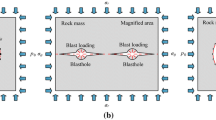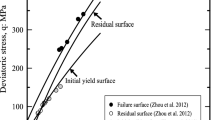Abstract
Due to the exhaustion of shallow resources, the underground roadway used for coal mining has reached the depth of 1000 m. The zonal disintegration phenomenon (ZDP) in deep rock mass will appear with the increase of depth which is widely different from shallow failure mode.In order to reveal the formation mechanism of ZDP, a new theoretical model is proposed. Based on the strain gradient theory and the deformation theory of plasticity, an elastoplastic damage softening model considering of dynamic excavation is put forward. The dynamic equations and boundary equations are expressed through the Runge–Kutta method. The numerical analysis of rock mass failure induced by blast loading and transient release of in-situ stress after blasting excavation is compiled by Matlab program. Taking the deep tunnel of Dingji coal mine in Huainan mine area as engineering background, the theoretical solutions of radial displacement and stresses present an oscillating mode. The theoretical values are in good agreement with the field measured results in terms of magnitude and change law. The applicability of the elastoplastic damage softening model for ZDP is confirmed and the model can be used to provide theoretical support for the deformation and failure of surrounding rock in deep underground engineering.











Similar content being viewed by others
Abbreviations
- \(\ddot{u_{k}}\) :
-
Two order derivative of the displacement on time
- \(\varDelta r\) :
-
The space step
- \(\delta\) :
-
Modification parameter of the damage variable
- \(\delta _{ij}\) :
-
Kronecker symbol
- \(\eta _{ijk}\) :
-
High order strain tensor
- \(\gamma\) :
-
Isentropic exponent of explosives
- \(\lambda\) :
-
Lame constant
- \(\rho _{0}\) :
-
The density of the rock mass
- \(\rho _{e}\) :
-
The density of explosives
- \(\sigma _1\) :
-
The first principal stress
- \(\sigma _{0}\) :
-
Residual stress
- \(\sigma _{\theta \theta }\) :
-
Tangential stress
- \(\sigma _{\theta \theta }^{*}\) :
-
The generalized tangent stress
- \(\sigma _{c}\) :
-
Uniaxial compressive strength
- \(\sigma _{f}\) :
-
Peak stress
- \(\sigma _{ij}\) :
-
Two order Cauchy stress tensor
- \(\sigma _{rr}\) :
-
Radial stress
- \(\sigma _{rr}^{*}\) :
-
The generalized radial stress
- \(\sigma _{s}\) :
-
Yield stress
- \(\sigma _{t}\) :
-
The tensile strength
- \(\sigma _{zz}\) :
-
Axial stress
- \(\sigma _{zz}^{*}\) :
-
The generalized axial stress
- \(\tau\) :
-
The time step
- \(\tau _{ijk}\) :
-
Three order stress
- \(\tilde{\sigma }\) :
-
Equivalent stress
- \(\tilde{\varepsilon }\) :
-
Equivalent strain
- \(\upsilon\) :
-
Poisson ratio
- \(\varepsilon _1\) :
-
The first principal strain
- \(\varepsilon _{0}\) :
-
Residual strain
- \(\varepsilon _{\theta \theta }\) :
-
Tangential strain
- \(\varepsilon _{f}\) :
-
Peak strain
- \(\varepsilon _{ij}\) :
-
Eulerian strain tensor
- \(\varepsilon _{rr}\) :
-
Radial strain
- \(\varepsilon _{s}\) :
-
Yield strain
- \(\varepsilon _{u}\) :
-
Ultimate strain
- \(\varepsilon _{z0}\) :
-
Initial axis strain
- \(\varphi\) :
-
Internal friction angle
- a :
-
Theoretical excavating radius
- b :
-
Radius of disturbed zone
- \(C_{f}\) :
-
The average speed of expansion
- \(C_{u2}\) :
-
The reflected wave velocity spread
- \(d_{b}\) :
-
Diameter of blast hole
- \(d_{c}\) :
-
Diameter of cartridge
- \(D_{e}\) :
-
Detonation velocity of explosives
- \(D_{i}\) :
-
Surface gradient operator
- E :
-
Elastic modulus
- G :
-
Lame constants
- \(k_{1},\, k_{2}\) :
-
Small parameter perturbation terms
- \(L_{1}\) :
-
Length of the charging section
- \(L_{2}\) :
-
Length of the blockage section
- \(n_{i}\) :
-
Surface normal vector
- P(t):
-
Dynamic pressure on inner wall
- \(P_{0}\) :
-
In-situ stress
- \(P_{a}\) :
-
The pressure on the inner wall of the cylinder
- \(P_{b}\) :
-
The pressure on the outer wall of the cylinder
- \(P_{eb}\) :
-
Equivalent peak load of the blasting load
- \(P_{z}\) :
-
Axial stress
- \(r_{p}\) :
-
Radius of plastic zone
- S :
-
Distance of adjacent blast holes
- \(t_{b}\) :
-
Start time of in-situ stress transient release
- \(t_{d}\) :
-
Time of positive pressure
- \(t_{r}\) :
-
Time of the basting load rising
- \(u_{i}\) :
-
Macroscopic displacement of material
- \(u_{r}\) :
-
Radial displacement
- \(u_{z}\) :
-
Axial displacement
References
Davis WC (1987) The detonation of explosives. Sci Am 256(256):106–112
Eshel NN, Rosenfeld G (1975) Axi-symmetric problems in elastic materials of grade two. J Frankl Inst 299(1):43–51
Fang Z, Harrison JP (2002) Application of a local degradation model to the analysis of brittle fracture of laboratory scale rock specimens under triaxial conditions. Int J Rock Mech Min Sci 39(4):459–476
Fleck N, Hutchinson J (1993) A phenomenological theory for strain gradient effects in plasticity. J Mech Phys Solids 41(12):1825–1857
Geers MGD (1997) Experimental analysis and computational modelling of damage and fracture. Technische Universiteit Eindhoven, Eindhoven
He MC, Xie HP, Peng SP, Jiang YD (2005) Study on rock mechanics in deep mining engineering. Chin J Rock Mech Eng 24(16):2803–2813
Kohn R, Temam R (1983) Dual spaces of stresses and strains, with applications to Hencky plasticity. Appl Math Optim 10(1):1–35
Lu W, Yang J, Chen M, Zhou C (2011) Mechanism and equivalent numerical simulation of transient release of excavation load for deep tunnel. Chin J Rock Mech Eng 30(6):1089–1096
Lu W, Yang J, Yan P, Chen M, Zhou C, Luo Y, Jin L (2012) Dynamic response of rock mass induced by the transient release of in-situ stress. Int J Rock Mech Min Sci 53:129–141
Ma X, Yang D, Liu F (2011) A nearly analytic symplectically partitioned Runge–Kutta method for 2-D seismic wave equations. Geophys J Int 187(1):480–496
Mindlin RD (1964) Micro-structure in linear elasticity. Arch Ration Mech Anal 16(1):51–78
Mindlin RD (1965) Second gradient of strain and surface-tension in linear elasticity. Int J Solids Struct 1(4):417–438
Pan Y, Wang ZQ (2005) Elasto-plastic analysis on surrounding rock of circular chamber based on strain nonlinear softening. Chin J Rock Mech Eng 24(6):915–920
Pan Y, Wang Z (2006) Study on stress distribution of surrounding rock and work condition of tunnel based on strain nonlinear hardening and softening. Chin J Rock Mech Eng 25(7):1343–1351
Qi C, Qian Q (2009) Basic problems of dynamic deformation and fracture of rock mass. Science Press, Beijing
Qian Q (2004) The current development of nonlinear rock mechanics: the mechanics problems of deep rock mass. In: Proceedings of the 8th conference on rock mechanics and engineering, Beijing
Qian Q, Zhou X, Xia E (2012) Effects of the axial in situ stresses on the zonal disintegration phenomenon in the surrounding rock masses around a deep circular tunnel. J Min Sci 48(2):276–285
Rui-lang C, Shao-hui H, Jing W, Fang W (2013) Study of modified statistical damage softening constitutive model for rock considering residual strength. Rock Soil Mech 34(6):1652–1660
Sheng-hong C, Hong-ru W, Wl XIONG (1990) The effect of couple stress on jointed rock mass. J Hydraul Eng 1:44–48
Shucai LI, Wang H, Qian Q, Shuchen LI, Fan Q, Yuan L, Xue J, Zhang Q (2008) In-situ monitoring research on zonal disintegration of surrounding rock mass in deep mine roadways. Chin J Rock Mech Eng 27(8):1545–1553
Shuchen LI, Qian Q, Zhang D, Shucai LI (2009) Analysis of dynamic and fractured phenomena for excavation process of deep tunnel. Chin J Rock Mech Eng 28(10):2104–2112
Tao Z, Dong Z, Lu W (1994) A theoretical analysis and calculation of the pressure course of unstemmed borehole. J Wuhan Univ Hydraul Electr Eng 27(4):394–9
Wang X, Pan Y, Ren W (2003) Instability criterion of shear failure for rock specimen based on gradient-dependent plasticity. Chin J Rock Mech Eng 22(5):747–750
Wang M, Jie LI, Kairui LI (2015) A nonlinear mechanical energy theory in deep rock mass engineering and its application. Chin J Rock Mech Eng 34(4):659–667
Wang C, Zhang Q, Xiang W (2017) Physical and numerical modeling of the stability of deep caverns in Tahe oil field in China. Energies 10(6):769
Yang G (2004) An introduction to elastic–plastic mechanics. Peoples Education Press, Beijing
Zhang WU, Guang-Li XU, Li WU, Qian YE (2009) Mechanical deformation characteristics of rock mass surrounding lateral enlarging excavation of tunnels with ultra-large sections. Chin J Geotech Eng 31(2):172–177
Zhang X, Yang D, Song G (2014) A nearly analytic exponential time difference method for solving 2D seismic wave equations. Earthq Sci 27(1):57–77
Zhang Q, Zhang X, Wang Z, Xiang W, Xue J (2017) Failure mechanism and numerical simulation of zonal disintegration around a deep tunnel under high stress. Int J Rock Mech Min Sci 93:344–355
Zhao J, Pedroso D (2008) Strain gradient theory in orthogonal curvilinear coordinates. Int J Solids Struct 45(11):3507–3520
Zhou X, Qian Q (2007) Zonal fracturing mechanism in deep tunnel. Chin J Rock Mech Eng 26(5):877–885
Zhou X, Qian Q (2013) Non-euclidean model of failure of deep rock masses under incompatible deformation. Chin J Rock Mech Eng 32(4):767–774
Zhou W, Zhao J, Liu Y, Yang Q (2002) Simulation of localization failure with strain-gradient-enhanced damage mechanics. Int J Numer Anal Methods Geomech 26(8):793–813
Zhou X, Zhou M, Qian Q (2012) Influence of rock damage on zonal disintegration around deep circle tunnels. Chin J Solid Mech 33(3):242–250
Acknowledgements
This study was financially supported by the National Key Research and Development Program of China (No. 2016YFC0401804-03), the Project of Taishan scholar Engineering, the National Natural Science Foundation of China (No. 41772282), the Preliminary Research Project of the Underground Experimental Project for the Geological Disposal of High-level Radioactive Waste (No. YKKY-J-2015-25). The authors are deeply grateful for the support.
Author information
Authors and Affiliations
Corresponding author
Rights and permissions
About this article
Cite this article
Gao, Q., Zhang, Q. & Xiang, W. Mechanism of Zonal Disintegration Phenomenon (ZDP) Around Deep Roadway Under Dynamic Excavation. Geotech Geol Eng 37, 25–41 (2019). https://doi.org/10.1007/s10706-018-0586-8
Received:
Accepted:
Published:
Issue Date:
DOI: https://doi.org/10.1007/s10706-018-0586-8




